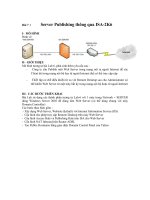Chinas publishing industry
Bạn đang xem bản rút gọn của tài liệu. Xem và tải ngay bản đầy đủ của tài liệu tại đây (2.23 MB, 322 trang )
CHINA’S
PUBLISHING
INDUSTRY
This page intentionally left blank
CHINA’S
PUBLISHING
INDUSTRY
From Mao to the Market
QIDONG YUN
Cheung Kong School of Journalism and
Communication, Shantou University,
Guangdong, China
Chandos Publishing is an imprint of Elsevier
50 Hampshire Street, 5th Floor, Cambridge, MA 02139, United States
The Boulevard, Langford Lane, Kidlington, OX5 1GB, United Kingdom
Copyright r 2019 Elsevier Ltd. All rights reserved.
No part of this publication may be reproduced or transmitted in any form or by any means,
electronic or mechanical, including photocopying, recording, or any information storage and
retrieval system, without permission in writing from the publisher. Details on how to seek
permission, further information about the Publisher’s permissions policies and our arrangements
with organizations such as the Copyright Clearance Center and the Copyright Licensing Agency,
can be found at our website: www.elsevier.com/permissions.
This book and the individual contributions contained in it are protected under copyright by the
Publisher (other than as may be noted herein).
Notices
Knowledge and best practice in this field are constantly changing. As new research and experience
broaden our understanding, changes in research methods, professional practices, or medical
treatment may become necessary.
Practitioners and researchers must always rely on their own experience and knowledge in evaluating
and using any information, methods, compounds, or experiments described herein. In using such
information or methods they should be mindful of their own safety and the safety of others,
including parties for whom they have a professional responsibility.
To the fullest extent of the law, neither the Publisher nor the authors, contributors, or editors,
assume any liability for any injury and/or damage to persons or property as a matter of products
liability, negligence or otherwise, or from any use or operation of any methods, products,
instructions, or ideas contained in the material herein.
British Library Cataloguing-in-Publication Data
A catalogue record for this book is available from the British Library
Library of Congress Cataloging-in-Publication Data
A catalog record for this book is available from the Library of Congress
ISBN: 978-0-08-100919-2 (print)
ISBN: 978-0-08-101003-7 (online)
For information on all Chandos Publishing publications
visit our website at />
Publisher: Glyn Jones
Acquisition Editor: Glyn Jones
Editorial Project Manager: Katie Chan
Production Project Manager: Debasish Ghosh
Cover Designer: Alan Studholme
Typeset by MPS Limited, Chennai, India
CONTENTS
List of Figures
List of Tables
Acknowledgments
List of Abbreviations
ix
xi
xiii
xv
1. Introduction
1
1.1 Media Transformation in China
1.2 Focus and Approach
1.3 Organization of the Book
Endnotes
References
2. Mapping Book Publishing in China
2.1 Publishing as a Business
2.2 Regulation, Administration, and Control
2.3 Decentralization in Book Publishing
2.4 Privatization and Internationalization
2.5 Booksellers and the Supply Chain
2.6 Problems of Chinese Book Publishing
2.7 Recent State Policies
2.8 Summary
Endnotes
References
3. From Communization to Commercialization: China’s Publishing
From 1949 to 1992
3.1 Communization of Publishing: 1949À56
3.2 Operation of Planned Book Publishing: 1956À79
3.3 Commercialization of Book Publishing: 1979À92
3.4 Summary
Endnotes
References
4. Ideology and the Commercialization of Book Publishing in China
4.1 China’s Shaky Ideology Before the Economic Reform
4.2 China’s Ideology in Flux
3
9
13
15
16
19
19
24
33
43
50
53
58
61
62
63
67
70
87
97
103
104
105
109
111
113
v
vi
Contents
4.3 Ideology and Publications
4.4 Commercialization of Publishing and Ideology
4.5 Ideology, Intellectuals, and Politics
4.6 Summary
Endnotes
References
5. Conglomeration: The Formation of Publishing Groups
5.1 The Different Stages of the Conglomeration of Publishing
5.2 Institutional Organization
5.3 Economic Advantages
5.4 Globalization and Publishing Groups
5.5 Summary
Endnotes
References
6. Corporatization: The Transition to Enterprises
6.1 Introduction
6.2 The Status of Publishing Houses
6.3 The Reform of Public Service Units and the Transformation
of Publishing Houses
6.4 Economic Sustainability and the Corporatization of Publishing Houses
6.5 The Reform of State-Owned Enterprises and the Commercialization
of Publishing Houses
6.6 Summary
Endnotes
References
7. Digital Publishing: Challenges and Opportunities
7.1 Overview
7.2 e-Books in Trade Publishing
7.3 Online Fiction Publishing
7.4 Summary
Endnotes
References
8. Politics, Profit and Digital Prospect: Guangdong Provincial
Publishing Group as a Case
8.1 Background
8.2 The Conglomeration of GDPG
115
118
120
122
123
123
129
130
137
143
150
154
155
156
161
162
165
168
177
186
188
189
191
197
198
200
210
216
216
217
221
221
223
Contents
8.3 The Corporatization of GDPG
8.4 Persistent Powers: GDPG and Party Politics
8.5 Digital Publishing: New Technology, Old Business Model
8.6 Summary
Endnotes
References
Conclusion
Appendix 1: GDPG Activities in 2005
Appendix 2: Intervention of the Party-State in the Activities of GDPG (2005)
Index
vii
232
235
249
254
254
255
257
261
275
289
This page intentionally left blank
LIST OF FIGURES
Figure 2.1
Copublishing supply chain in China’s trade publishing.
52
ix
This page intentionally left blank
LIST OF TABLES
Table 2.1
Table 2.2
Table 2.3
Table 2.4
Table 2.5
Table 2.6
Table 2.7
Table 2.8
Table 2.9
Table 2.10
Table 2.11
Table 2.12
Table 2.13
Table 2.14
Table 2.15
Table 3.1
Table 3.2
Table 3.3
Table 3.4
Table 3.5
Table 3.6
Table 3.7
Table 3.8
Table 5.1
Table 5.2
Table 6.1
Table 7.1
Table 7.2
Table 8.1
Table 8.2
Overview of China’s book publishing industry (1950À2016)
Book consumption per person in China
Number of book publishers
Annual retail sales of top 20 publishers in 2015
Top 10 publishing groups in the retail market: January to
October 2015
Top 10 Publishers by Sales Revenue in 2013
Total number of publishing houses in different provincial
regions (collated in January of 2010)
Title output by regions (2015)
Regional book sales from state-owned booksellers (2013)
Book imports in China (by value and volume): 2011À2016
Rights licensing of books acquired by Chinese publishers:
2011À2016
Export of licensed rights by Chinese publishers (2009À2016)
Percentage of school books in China’s book market
(2012À16)
Total inventory and total annual sales (by volume and value)
Top ten publishing groups in term of economic strength
(2015)
Periods of publishing history during the People’s Republic
(1949À92)
Number of publishers (1950À56)
Title output of China’s book publishing (1947À54)
Output of machine-made paper and paperboard (1955À62)
Title output of China’s book publishing (1965À76)
Number of publishers (1971À79)
Number of publishers (1979À92)
Title output of publishers (1979À89)
Key events in the process of conglomeration and
corporatization
List of publishing groups in China
Numbers of students and schools during the stage of
compulsory education (2006À11)
Sales of digital publications (including e-books): 2012À16
Annual revenue of national digital publishing parks in China
in 2015 (billion yuan)
Business areas of GDPG and its member firms
Annual revenue and profit of SPM (million yuan)
21
21
34
36
37
37
39
40
41
47
48
50
56
57
60
68
75
82
90
92
96
99
101
130
135
180
202
209
224
248
xi
This page intentionally left blank
ACKNOWLEDGMENTS
This book stems from my research at Loughborough University a few
years ago. In order to keep up with the developments in China’s publishing industry and to verify the conclusions of my research, I have followed
up with regular visits to the main site of my research in Guangdong, and
found that the main arguments of my earlier research appear to have sustained the test of time. I would like to express my deep gratitude to
Professor Graham Murdock at Loughborough University. Without his
generous support and inspiration, this book would not have been possible.
I am also grateful to Professor James Stanyer and Professor Chris Berry
for offering me invaluable advice on an earlier version of this research.
Professor Paul Richardson and Angus Phillips from the Oxford
International Centre for Publishing Studies at Oxford Brookes University
also read earlier drafts of some chapters, and I sincerely thank them for
their comments and feedback.
I am extremely grateful to all my friends, particularly Sanguo Cheng
and Yanhong Kong, in the publishing industry in China. They have generously shared their views with me and sometimes helped me to get in
touch with other professionals in the industry. However, I have to protect
the anonymity of most of them either because they wanted to stay anonymous or because they may have touched on sensitive topics. My gratitude
also goes to my colleagues at Shantou University, especially Dongsheng
Fan, Jing Bai, Dharma N. Adhikari, John H. Noonan, and Linjun Fan,
for their assistance and moral support. Three postgraduate students,
Haimian Huang, Xining Yin, and Xingyu Zhang, provided assistance in
checking the references in the book.
I am deeply indebted to Shaolin, Zhiya, Liuli, and Lutian. Without
their love and support, I could not have completed this book.
Earlier versions of parts of this book have been published previously
in the Journal of Scholarly Publishing 45. 2 (2014): 142À171 (doi:
10.3138/jsp.45.2.003) and LOGOS: Journal of the World Publishing
Community 24. 1 (2013): 19À29. I thank the University of Toronto
Press (www.utpjournals.com) and Brill (www.brill.com) for their permission to reuse parts of my own articles.
Finally, I would like to thank Glyn Jones, Katie Chan, Debasish
Ghosh, and George Knott at Elsevier for their patience and flexibility.
xiii
This page intentionally left blank
LIST OF ABBREVIATIONS
APP
APPRFT
AR
B2C
BAT
CAC
CCP
CD
CEPIEC
CNNIC
CNKI
CNPIEC
ELT
GAPP
GDPG
GPPH
IPO
ISBN
KDP
MPR
NCAC
NDRC
NRI
OECD
PEP
PPP
PPB
SAPPRFT
SARS
SOE
SPPA
STM
SPM
WTO
Administration of Press and Publication
Administration of Press, Publication, Radio, Film, and Television
Augmented Reality
Business-to-Consumer
Baidu, Alibaba, and Tencent
Cyberspace Administration of China
Chinese Communist Party
Compact Disc
China Educational Publications Import & Export Corporation
China Internet Network Information Centre
China National Knowledge Infrastructure
China National Publications Imports and Exports Corporation
English Language Teaching
General Administration of Press and Publication
Guangdong Provincial Publishing Group
Guangdong People’s Publishing House
Initial Public Offering
International Standard Book Number
Kindle Direct Publishing
Multimedia Print Reader
National Copyright Administration of China
National Development and Reform Commission
Network Readiness Index
Organisation for Economic Cooperation and Development
People’s Education Press
Purchase Parity Power
Press and Publishing Bureau
State Administration of Press, Publication, Radio, Film, and Television
Severe Acute Respiratory Syndrome
State-Owned Enterprise
State Press and Publication Administration
Science, Technology, and Medicine
Southern Publishing and Media Company
World Trade Organization
xv
This page intentionally left blank
CHAPTER 1
Introduction
This book is a study of the transformation of China’s contemporary book
publishing industry, but it also contributes to the understanding of media
transformation in China as a whole. Chinese media, including book publishing, has undergone significant changes since the start of economic
reforms at the end of the 1970s. Much research has been carried out to
understand the commercialization of the media industry in China and its
possible political implications. Scholars interested in Chinese creative
industries have also explored the compatibility of the concept of creativity
with the rigid regulatory regimes in China’s media industry (Keane,
2013; Wang, 2004). However, book publishing appears to have generally
been ignored by researchers.
Despite the fact that books have played an essential role in our cultural
lives for centuries, publishing has been much less studied in comparison
with other, more publicly visible sectors, such as the press and broadcasting. Research by Thompson (2005, 2012) is among the handful of recent
scholarly contributions to the understanding of the publishing industry in
Western countries, Britain and the United States in particular.
Concerning contemporary book publishing in China, the collection edited by Baensch (2003) and the book by Xin (2010) provided some industry information in English. But some of the industry information
contained in these two books is now a bit dated. More importantly, both
books hardly go beyond providing descriptive information, leaving deep
questions unanswered, such as how the publishing industry in China,
under the dual pressures of market competition and the state control, is
structured and what the dynamics behind the daily operations of publishers are.
It is quite unfortunate that the book publishing in China has not been
well studied. Although the publishing industry in China is a relatively
small sector in the cultural industries, it is “a major source of content for
other media and cultural industries” (Thompson, 2005: 3). In addition,
research on the transformation of China’s book publishing can not only
fill a gap in our present knowledge, but also enrich our understanding of
China’s media as a whole for a couple of reasons. First, treating “the
China’s Publishing Industry
DOI: />
© 2019 Elsevier Ltd.
All rights reserved.
1
2
China’s Publishing Industry
media” as a single system is seriously misleading in developing our understanding of the impact of transition since different media sectors face different political and economic situations in China. Detailed studies of
particular sectors are essential. Second, book publishing, as a print media,
is a well-established industry with a much longer history than the development of broadcasting or the Internet in China. It therefore offers us an
extended period in which to investigate its relationship with the partystate. Last but not least, book publishing is arguably less immediately
politically sensitive than the major popular news media of press and
broadcasting, and its commercialization has been pushed further than
other print and broadcasting media sectors. This is exemplified in the fact
that several publishing groups have been listed on China’s stock market,
something that has rarely happened in the press and broadcasting media
sectors.
As Tsou (1986: xli) has rightly suggested, the change in the relationship between the party-state and society is uneven in different social
sectors. Reform of the media system, due to its ideological sensitivity, has
generally lagged behind other industries. Within the media industry, different sectors also exhibit different levels of ideological sensitivity. The
more closely a media sector affects the exercise of power in society, the
stronger the motive for scrutiny or control from interest groups
(McQuail, 2000: 31). As book publishing is less ideologically sensitive, it
could be commercialized further than other media sectors, which makes
it a unique arena for understanding the media commercialization in
China. Pei (1994: 161) has also argued that book publishing was ideologically “the (media) industry that experienced the highest level of pluralization and liberalization in China during reform.” The party-state, being
cautious about the reform of the media system, appears to be using book
publishing as a test field for its reform policies before extending them to
other media sectors. An example is the newspaper publishing. Most
market-oriented newspaper publishers had been transformed from public
institutions (or public service units) (shiye danwei) into enterprises (qiye)
by the end of 2012, following exactly the route of corporatization in the
book publishing industry.
Book publishing is less politically sensitive because of its more cultureoriented content, long production process, and usually limited numbers
of readers. Books in China were traditionally used to preserve officially
sanctioned wisdom or knowledge of the natural and social worlds.
Although modern printing technology and the expansion of basic literacy
Introduction
3
extended their role, the rise of modern audio visual media marginalized
them as a means of mass communication. Consequently, preservation of
knowledge and the use in education are still the major roles of the state
book publishing in China. Due to this intrinsic role, book publishing
touches on current political affairs less frequently than news media. On
top of that, the production process is much longer than most other
media. The party-state, since it could intervene much more easily in this
process, may feel less obliged to subjugate publishing houses to stringent
daily control. Consequently book publishing could enjoy slightly more
operational autonomy. More importantly, readers of a book are usually
limited in numbers in comparison with other media sectors. If we accept
that “educational” or “serious” media do not usually reach large numbers
of receivers and so are “marginal to power relations” (Mcquail, 2000: 31),
it is entirely plausible to argue that book publishing is likely to be less
ideologically sensitive because of its limited readership.
1.1 MEDIA TRANSFORMATION IN CHINA
China’s publishing industry is very different from that in Western countries in the sense that it is still not fully market-driven. Like other sectors
of the media in China, the state control features prominently in the operation of the industry. Any attempt to understand China’s publishing
industry has to take this into account and to situate the discussion in a
broad social context.
China is still a party-state ruled by the Chinese Communist Party
(CCP) and claims to be upholding the “socialism with Chinese characteristics.” However, as the economic reforms over the past four decades have
changed nearly every aspect of the society, China has departed so radically
from the planned system of the Maoist period that some scholars argued
that it is better defined as “capitalism with Chinese characteristics”
(Huang, 2008). With the economy becoming increasingly integrated into
the world capitalist system, many have wondered whether the Party could
maintain a tight control over the cultural life, which is crucial for its
monopoly of political power. The constitution and transformation of
China’s media system is central to this debate because, uniquely among
economic sectors, the media and cultural industries, not only play an
increasingly important role in sustaining economic growth, but also provide the major symbolic sites on which public culture is constituted.
4
China’s Publishing Industry
China’s media have been defined as the “mouthpiece” of the Party
and have played an instrumental role in supporting the Party’s grip of
power. The Party’s early struggle for political power and its subsequent
political mass campaigns after the establishment of the People’s Republic
relied heavily on ideological propaganda. Disseminating this was the
central role of the Party controlled media. As the party-state after Mao
has increasingly relied on economic performance as its source of legitimacy however, the role of the media has been shifted from being a statesponsored propaganda “mouthpiece” into a hybrid system marked by
commercialization. The media and cultural industries now not only play
an important role in fostering the development of other industries, but
have been themselves classified by the Chinese government as a “pillar”
industry in its 12th five-year plan.
The potential political implications of this transformation have
attracted increasing comment and speculation. Because the media continue to follow political dynamics due to its ideological role but are also
increasingly shaped by market dynamics, the conflict and compromise
between these two dynamics makes them a potent vantage point for
understanding the paradox of China’s transformation. Although much
research on China’s media has centered on the political implications of
media commercialization (e.g., Stockmann, 2013; Lee, 2000; Zhao,
1998), comparatively little effort has been expended on understanding
how the media have been commercialized. It seems to be taken for
granted that the commercialization of the media system is inevitable as
the whole society is changing under the impact of economic reforms.
Although this is true, it does not help us much in developing a more indepth understanding of the institutional transformation of China’s media.
Since media institutions are part of the overall structure of society
(McQuail, 2000: 61), we need to take into account the impact of broad
social transformation on media institutions. The main task is not just to
state the linkage between media commercialization and the social transformation, but to illustrate how it operates in practice. In developing a
fuller understanding of media commercialization, overemphasis either on
a monolithic and all-powerful state or an emancipating market force
should be avoided. China’s media system is full of contradictions, and different forces and players have to operate under constraints. Murdock and
Golding (2005: 63), when discussing the contradictions within capitalist
media systems, argued that the key players “cannot always do as they
would wish” and it is important to analyze “the nature and sources of
Introduction
5
these limits.” It is also an important task to understand the contradictions
and structural limits within China’s media system. As we will see, the
commercialization of book publishing has been marked by tensions and
contradictions, between local and central government, between different
branches of central government, and between the hoped for outcomes of
particular policies introduced by the party-state and their unintended
consequences.
To avoid potential confusion between the two related terms of
“marketization (shichang hua)” and “commercialization (shangye hua),”
which are often used interchangeably, I incline to use “commercialization”
to describe the transformation of China’s media in this book. It has been
noticed that there is a convolution of the state and capital (Lee et al., 2007;
Winfield and Peng, 2005) during the commercialization of Chinese media,
while the “marketization level” is still very low (Wang, 2004: 16). This is
why I would like to differentiate these two terms. For me, “marketization”
implies an exposure to market forces at institutional level, while “commercialization” may just point to the business restructuring at the organizational level even though the progress toward a market mechanism is
stagnating. In a critique of the marketization of media in the West,
Murdock and Golding (1999: 8) defined marketization to be “policy interventions designed to increase the freedom of action of private corporations
and to institute corporate goals and organizational procedures as the yardsticks against which the performance of all forms of cultural enterprise are
judged.” Four dimensions to this main process have been identified, including privatization, liberalization, deregulation, and corporatization (Hardy,
2014: 58). Some of these processes may have happened to a limited extent
during the media transformation in China, but certainly not all.
In contrast, we can identify the process of commercialization as a
major force for change at both the institutional and content level of
China’s media. Before the economic reforms, the operation of media
organizations was tightly controlled by the Party and the “political indoctrination and mass mobilization” was their predominant task (Zhao,
1998: 4), though their precise role varied according to the political strategy of the Party during different periods. This political task waned after
the economic reforms. The party-state became less intrusive in content
production, and media organizations were given more operational autonomy. In addition, the media, formerly mainly or fully sponsored by the
party-state, were initially allowed and later encouraged to make profits in
line with the new emphasis on economic growth as the prime task of the
6
China’s Publishing Industry
party-state. With direct state bursaries being gradually reduced to nearly
nonexistent, media were entrusted with the double role of “mouthpiece
and money-spinner” (Zhao, 1999). This institutional commercialization,
however, could not move on without changes in the ideological context.
Before the economic reforms, media were permeated by political
ideology, with class struggle becoming the primary focus during periods
of upheaval such as the Cultural Revolution. As this role faded after the
economic reforms, media organizations and products proliferated, bringing about a more plural cultural realm. Although it would now be difficult to reverse these changes as a different socioeconomic foundation has
been created by the economic reforms (Chu, 1994: 17), the predominant
control of the party-state over the media continues. Media organizations
are still officially owned by the state and coercive power is constantly
resorted to when the media seems to be transgressing the boundary set by
the party-state.
Commercialization is the central but not the only important dynamics
underlying the transformation in China’s media. Stockmann (2013: 8)
referred the different aspects of Chinese “media marketization” as deregulation, commercialization, and privatization, intentionally choosing the
term of deregulation rather than decentralization to “stress its link” to a
global trend toward deregulation. However, I found decentralization is
much more pertinent in China’s case. The defining features of China’s
institutional economic reform, according to Chung (2001: 46), “may be
epitomized as the changes toward decentralization, marketization, and
privatization.” These changes are certainly reflected in the transformation
of China’s media but if we also take into account the impact of globalization, the transformation of China’s media might be summarized as commercialization, decentralization, privatization, and internationalization.
Privatization and internationalization are simply derivatives of the process
of commercialization, and their impact is still largely restricted by the
party-state. Decentralization, however, has emerged as another dynamics
which can hardly be neglected in any discussion of the commercialization.
Decentralization is one of those terms which are widely but loosely
used with a fluid boundary. Yu (2009: 17) has used it to describe not only
the diversified media outlets affiliated to ministries and local governments,
but also the emergence of “non-state media content providers.” Zhao
(2008: 96) has described this key change as “market fragmentation
along territorial and sectoral boundaries.” In the context of this book I
use the term of decentralization in a way similar to Zhao’s
Introduction
7
“market fragmentation,” referring to the rise of regional media and media
diversification at the central level. But “market fragmentation” is only
capable of describing the changes since the economic reforms. Assuming
that decentralization as a transformation process started only after the economic reforms would be far from the fact. Schurmann (1968: 175), when
discussing China’s economic policy during the Maoist period, distinguished two forms of decentralization, calling them “decentralization I”
and “decentralization II,” which means delegating decision-making power
to “production units themselves” or to lower level “regional administration,” respectively, and argued that the second of these was Mao’s strategy
of decentralization. Eckstein (1977: 131) has used the terms “market
decentralization” and “bureaucratic decentralization,” which are more
self-explanatory, to describe the increased autonomy of individual enterprises or devolution of power to local authorities. Clearly “market decentralization,” a central aspect of commercialization, was seldom considered
under Mao. Mao’s China oscillated between a “centralized command”
system and a “decentralized command” (ibid: 93) system, because centralization led to rigidity while decentralization led to disorder of the command system. Since most of China’s media sectors under Mao were either
not well developed (such as television broadcasting) or limited in numbers
and restricted in content coverage to regional levels (such as local Party
newspapers), they were not fully subject to cycles of centralization and
decentralization. But this cycle was clearly manifested in book distribution, as we will see in more detail in a later chapter.
Although bureaucratic decentralization occurred several times during
the Maoist period, it gathered a new momentum and expanded its scope
after the economic reforms, for several reasons. First, there was a political
consideration. The reformers encouraged the decentralization of economic issues in order to undermine “the power of conservative central
planners” (Breslin, 1996: 51). Second, China’s economic reforms adopted
a gradualist approach as the party-state did not have a clear overall blueprint for change. It was an essential part of this approach to allow regional
governments to initiate reform policies on a trial basis before the central
government decided to adopt or ban them. Third, given that the pervasive power of the state still predominates in economic and social life,
decentralization becomes an important way of promoting economic
development by encouraging the initiatives of regional governments.
Further, the fiscal decentralization started in 1980 greatly increased the
economic power of local governments. As a result, the party-state,
8
China’s Publishing Industry
according to Gries and Rosen (2004), is better called “states.” The political implication of economic decentralization, however, is limited. Despite
the changes since the reform, China “remains a communist party state”
and the central party-state “still controls the appointment of senior local
leaders (Goodman, 1994: 4). The center may tolerate local deviations on
economic issues “as long as they promote growth at the system level,” but
“political and organizational realms” are regulated by political reasoning
and deviation in these issues are rarely allowed (Chung, 2001: 65).
China’s media, now both an industry for profit and also a cultural arena
with ideological implications, are inevitably caught up in these dynamics.
The commercialization of China’s media is therefore intertwined with
decentralization. As the commercialization turned the media into profit
sources, local authorities and other central ministries were eager to establish media outlets for financial interests, and the profit accumulated in
commercialized media provided financial resources for their further
expansion. It is the proliferation of media outlets especially those affiliated
to local authorities that is the main driving force of decentralization of
media. Competition among the increasing number of media outlets has
also fostered commercialization. However, local governments tend to
impose trade barriers to protect their affiliated media organizations, and
this has hindered further commercialization of the media.
However, there are debates among researchers on the impact of
decentralization. While Wu (2000) argued that the party-state “still exercises tight control” over the media despite decentralization, Tong (2010)
declared that the “centralized media control theory” is in crisis due to the
rise of local power. Tong’s argument, although interesting, is less persuasive. Conceptually, Tong confused the interests of local bureaucrats with
local interests. Empirically, the cases that Tong mentioned, in which local
authorities controlled the coverage of local media on certain events
despite “the central government’s will” (ibid: 925), can be seen as cases of
local bureaucrats trying to conceal their policy failures or wrongdoings.
This kind of case is not unusual even in a centralized system and not
strong enough to demonstrate a decline in ideological control by the central party-state. Tong’s presumption that any will of the central party-state
in a centralized system should be implemented smoothly by its local
agents is flawed. This was not the case even during the Maoist period.1
By providing a detailed account of the transformation of the state publishing sector this study hopes to contribute to the more general debate on
the decentralization of media system.









